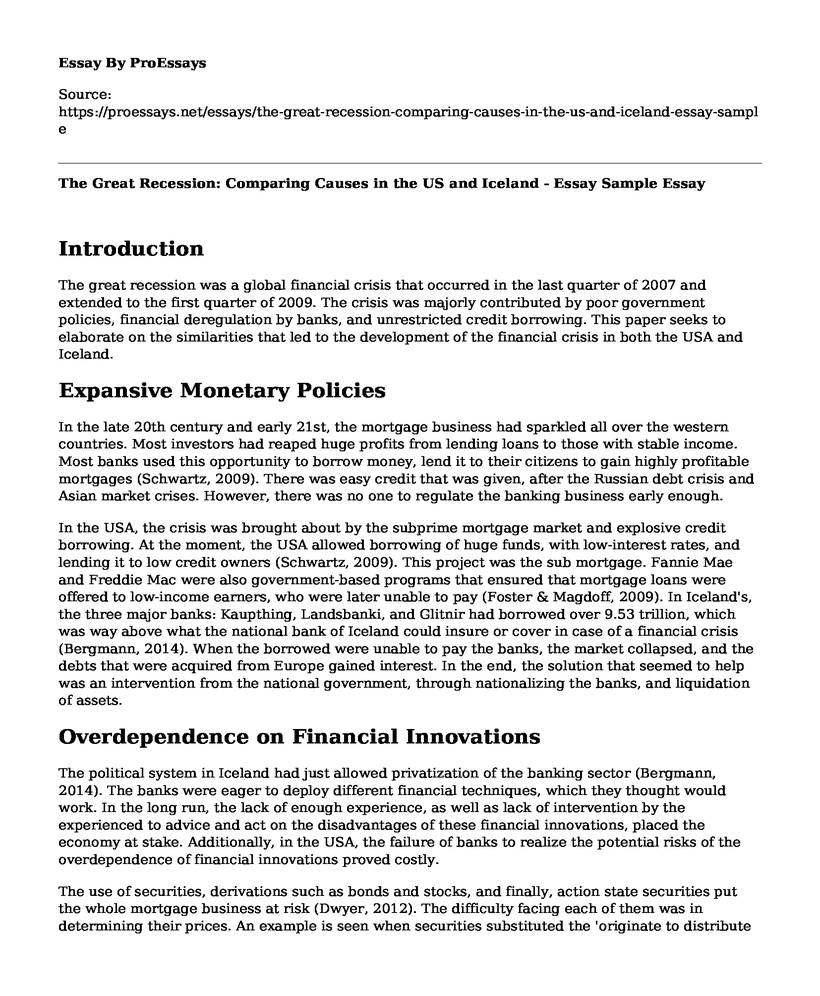Introduction
The great recession was a global financial crisis that occurred in the last quarter of 2007 and extended to the first quarter of 2009. The crisis was majorly contributed by poor government policies, financial deregulation by banks, and unrestricted credit borrowing. This paper seeks to elaborate on the similarities that led to the development of the financial crisis in both the USA and Iceland.
Expansive Monetary Policies
In the late 20th century and early 21st, the mortgage business had sparkled all over the western countries. Most investors had reaped huge profits from lending loans to those with stable income. Most banks used this opportunity to borrow money, lend it to their citizens to gain highly profitable mortgages (Schwartz, 2009). There was easy credit that was given, after the Russian debt crisis and Asian market crises. However, there was no one to regulate the banking business early enough.
In the USA, the crisis was brought about by the subprime mortgage market and explosive credit borrowing. At the moment, the USA allowed borrowing of huge funds, with low-interest rates, and lending it to low credit owners (Schwartz, 2009). This project was the sub mortgage. Fannie Mae and Freddie Mac were also government-based programs that ensured that mortgage loans were offered to low-income earners, who were later unable to pay (Foster & Magdoff, 2009). In Iceland's, the three major banks: Kaupthing, Landsbanki, and Glitnir had borrowed over 9.53 trillion, which was way above what the national bank of Iceland could insure or cover in case of a financial crisis (Bergmann, 2014). When the borrowed were unable to pay the banks, the market collapsed, and the debts that were acquired from Europe gained interest. In the end, the solution that seemed to help was an intervention from the national government, through nationalizing the banks, and liquidation of assets.
Overdependence on Financial Innovations
The political system in Iceland had just allowed privatization of the banking sector (Bergmann, 2014). The banks were eager to deploy different financial techniques, which they thought would work. In the long run, the lack of enough experience, as well as lack of intervention by the experienced to advice and act on the disadvantages of these financial innovations, placed the economy at stake. Additionally, in the USA, the failure of banks to realize the potential risks of the overdependence of financial innovations proved costly.
The use of securities, derivations such as bonds and stocks, and finally, action state securities put the whole mortgage business at risk (Dwyer, 2012). The difficulty facing each of them was in determining their prices. An example is seen when securities substituted the 'originate to distribute model,' to use of the hold mortgages. In the end, both the USA and Iceland faced a financial innovation problem since these mortgage-based securities and derivatives were different from evaluating and price. These mortgage-based securities were further spread to credit cards, student loans, and other loan categories. In the end, the designers of these programs of interexchange in finances and also issued any guidance on determining the prices of the security. The securities and banking supervisors understood the threats but ignored the risk due to the booming business.
Conclusion
In summary, the global financial crisis was a period of economic recession in late 2007 to realty 2009. It occurred as a result of default payments by mortgage loan holders, and this led to the collapse of the economy. The expansive monetary policies and overdependence on financial innovation played a crucial role in both the USA and Iceland's economic downfall.
References
Bergmann, E. (2014). Iceland and the international financial crisis: Boom, bust and recovery. Springer.
Dwyer, G. P. (2012). Financial innovation and the financial crisis of 2007-2008. Papeles de Economia Espana, 130.
Foster, J. B., & Magdoff, F. (2009). The great financial crisis: Causes and consequences. NYU Press.
Schwartz, A. J. (2009). Origins of the financial market crisis of 2008. Cato J., 29, 19.
Cite this page
The Great Recession: Comparing Causes in the US and Iceland - Essay Sample. (2023, Jul 17). Retrieved from https://proessays.net/essays/the-great-recession-comparing-causes-in-the-us-and-iceland-essay-sample
If you are the original author of this essay and no longer wish to have it published on the ProEssays website, please click below to request its removal:
- Answers to Questions on Macroeconomics
- Local and Global Business Opportunities for Countries Paper Example
- Global Inequality and Poverty Essay Example
- Macroeconomics: Assignment Example
- Essay on PCAOB: Regulating Independent Audits in the US Since 2002
- Paper Example on AWC's Debt: Uncovering the Core Causes
- Human Trafficking: Exploitation of Millions Through Coercion and Fraud - Essay Sample







